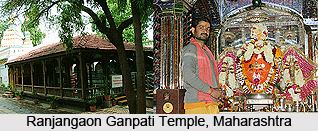 Ranjangaon Ganpati temple, located at a distance of about 50 km from Pune in the Indian state of Maharashtra, houses a shrine dedicated to Lord Ganesha. It is one of the Ashtavinayak temples that celebrate the eight instances of legends associated with Ganesha.
Ranjangaon Ganpati temple, located at a distance of about 50 km from Pune in the Indian state of Maharashtra, houses a shrine dedicated to Lord Ganesha. It is one of the Ashtavinayak temples that celebrate the eight instances of legends associated with Ganesha.
As per historical record the temple was constructed in between 9th and 10th century. Madhavrao Peshwa, the fourth Peshwa of the Maratha Empire built a room in the basement of the temple for enshrining the idol of Lord Ganesha. Later it was renovated by Sardar Kibe of Indore. Nagarkhana is positioned above the entrance gate. The architecture and design of the temple resembles the temple of the Peshwa`s period. The temple facing the eastern side is adorned with a huge and attractive entrance gate. The presiding deity of the temple, Lord Ganesha is also referred to as Mahotkat and it is said to possess 10 trunks and 20 hands.
The temple can be reached taking the Pune - Nagar highway route. Via Shikrapur Rajangaon it is 21 kms and from Pune it is 50 kms away.
This article is a stub. You can enrich by adding more information to it. Send your Write Up to content@indianetzone.com





















